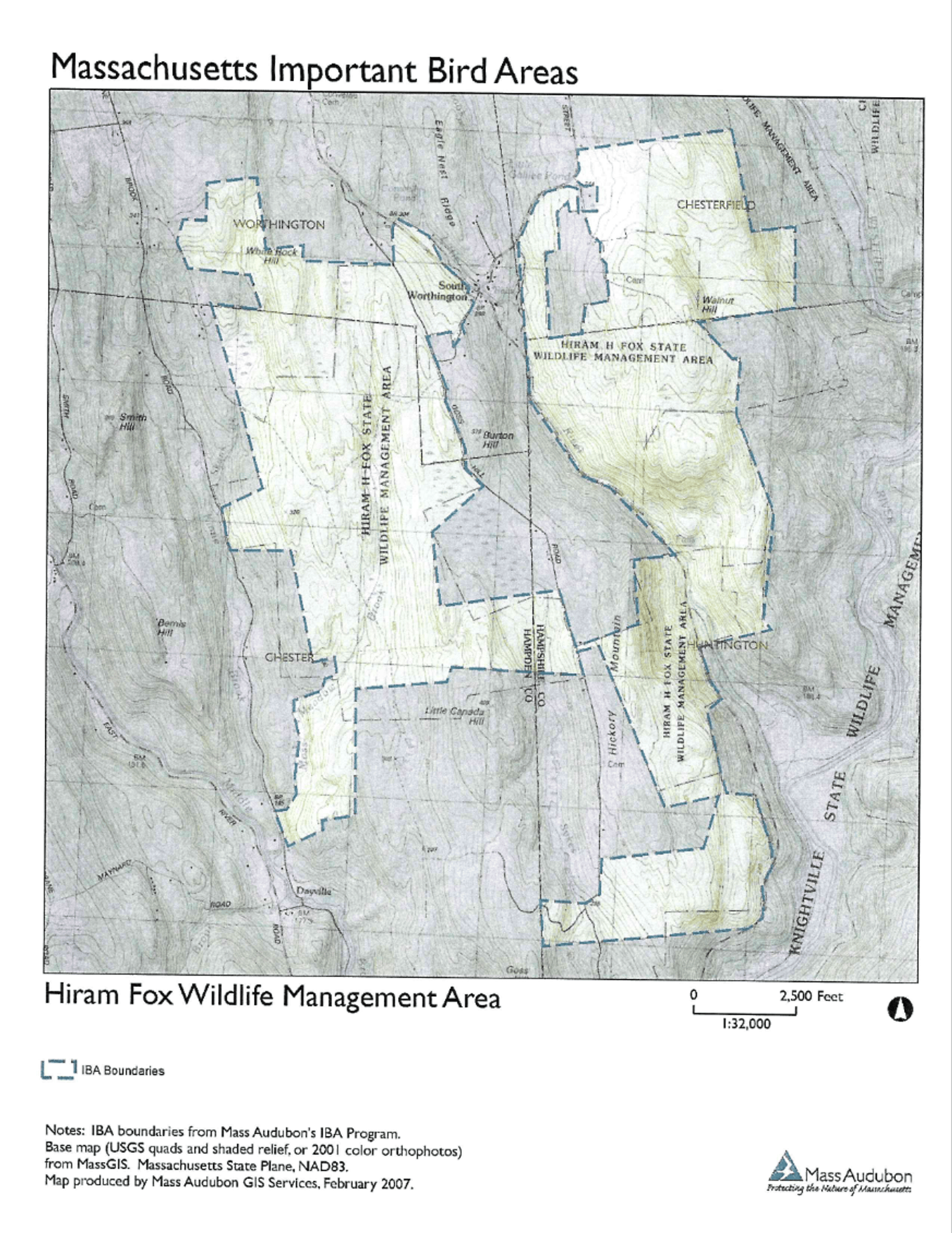Hiram Fox WMA (Hampshire Co.)
Hiram Fox WMA (Hampshire Co.)
Important Bird Area Chesterfield, Massachusetts 01012
Hiram Fox Wildlife Management Area (IBA) webpageHiram Fox Wildlife Management Area (IBA) map
Tips for Birding
There are sections of Hiram Fox Wildlife Management Area in Hampshire and Hampden counties. If you carefully keep your bird records by county, be aware of the location of the county line and use the appropriate hotspot or personal location.
Birds of Interest
During 2001 the ten most abundant species were (abundance in parentheses) Yellow-bellied Sapsucker (35), Red-eyed Vireo (217), Ovenbird (183), Black-throated Green Warbler (94), Veery (68), Wood Thrush (47), American Redstart (38), Black-and-white Warbler (32), and Black-throated Blue Warbler (26).
About this Location
Hiram Fox Wildlife Management Area (WMA) consists of rolling hills with some steep ledges and gullies. The forest habitat is mostly comprised of northern hardwoods of American beech, maples, birches, white ash, etc. along with scattered white pine. Elevation ranges from 700 to 1,200 feet. Several agricultural fields are located in the northeastern area of the WMA. Swamps, wetlands, and marshy areas can be found scattered throughout the WMA.
Roadside parking is located on Goss Hill Road and Huntington Road (MA-112) in Worthington, Ireland Street Extension in Chesterfield, and Kinne Brook Road in Chester.
The entire area comprises 3,200 acres of second-growth forest spread over four towns. The wildlife management area is a portion of this entire area (approximately 1,000 acres) and is located predominantly in Chester. The site comprises a relatively unfragmented forest with a limited amount of agriculture and rural development in the surrounding areas. Topography is characterized by moderate and occasional steep slopes, interspersed with upland and abrupt ledge outcrops. The site lies within the Westfield watershed and is interspersed with annual streams. Habitats within the area are primarily northern hardwoods (60%) with scattered occurrences of mixed northern hardwood/northern red oak (10%), mixed white pine/hardwoods (20%), and hemlock/hardwoods (10%). The IBA is exclusively forested, except for an interspersion of Beaver impoundments along the Moss Meadow Brook drainage totaling approximately 13 acres of upland forest, forested wetlands totaling approximately 30.3 acres, and at least 11 vernal pools. The overall wetland area is 44.4 acres or about 5% of the study area.
The site was specifically selected for a long-term breeding study of forest-nesting birds. The study is designed to be replicable, long-term, and open-ended using established stations along transects through the forest, and to establish accurate trend information on neotropical migrant land birds from the annual census. The study, begun in 1987, uses standard point count survey methods. In thirteen survey years, the 100-station subsample has produced a mean of 1,119 individuals, representing 58 species. At all 336 stations, 102 species have been recorded on the IBA. The area contains breeding populations of both state and regional high conservation priority species. This site was proposed for consideration for an IBA because of the long-term study in progress. The regrowth of forest clearings seems to be responsible for a decrease in species richness. In the early 1990s, forest clear-cuts and subsequent burns to maintain the clearings resulted in the appearance of nesting Mourning Warblers and a spectacular spike in the number of Chestnut-sided Warblers. These classic "fugitive species," as well as other early successional species such as the Alder Flycatcher, Eastern Kingbird, Gray Catbird, Indigo Bunting, and White-throated Sparrow have declined and have disappeared or have been reduced to trace occurrences. Numbers of deep forest species have mostly remained consistently robust.
Features
Restrooms on site
Wheelchair accessible trail
Entrance fee
Content from Hiram Fox Wildlife Management Area (IBA) webpage and Hiram Fox Wildlife Management Area information sheet
Last updated November 29, 2023
